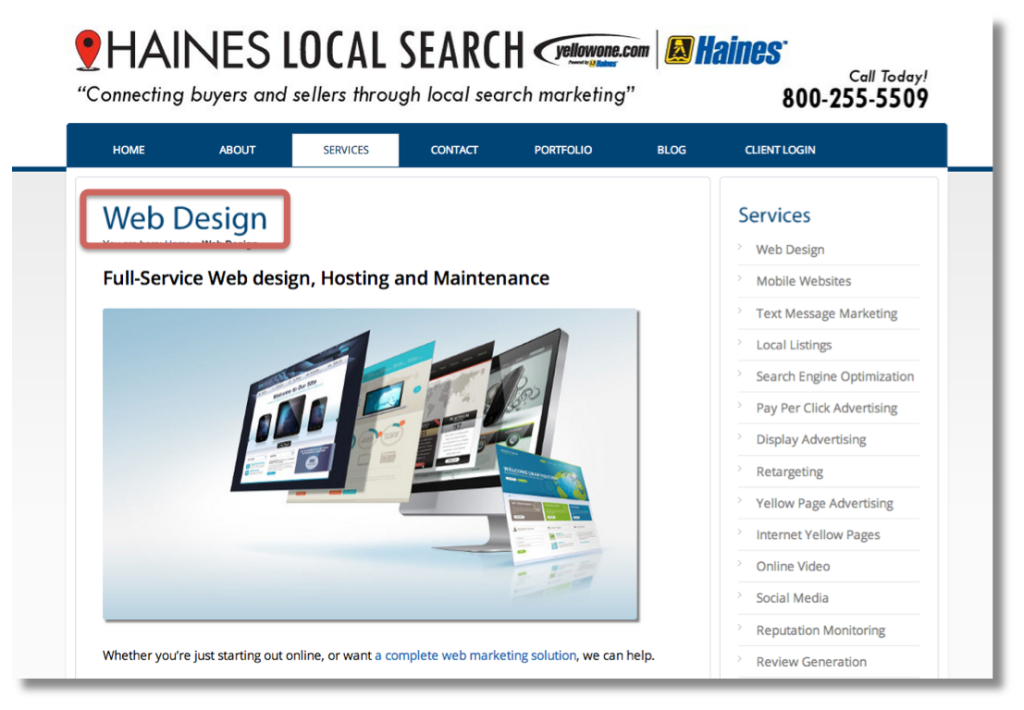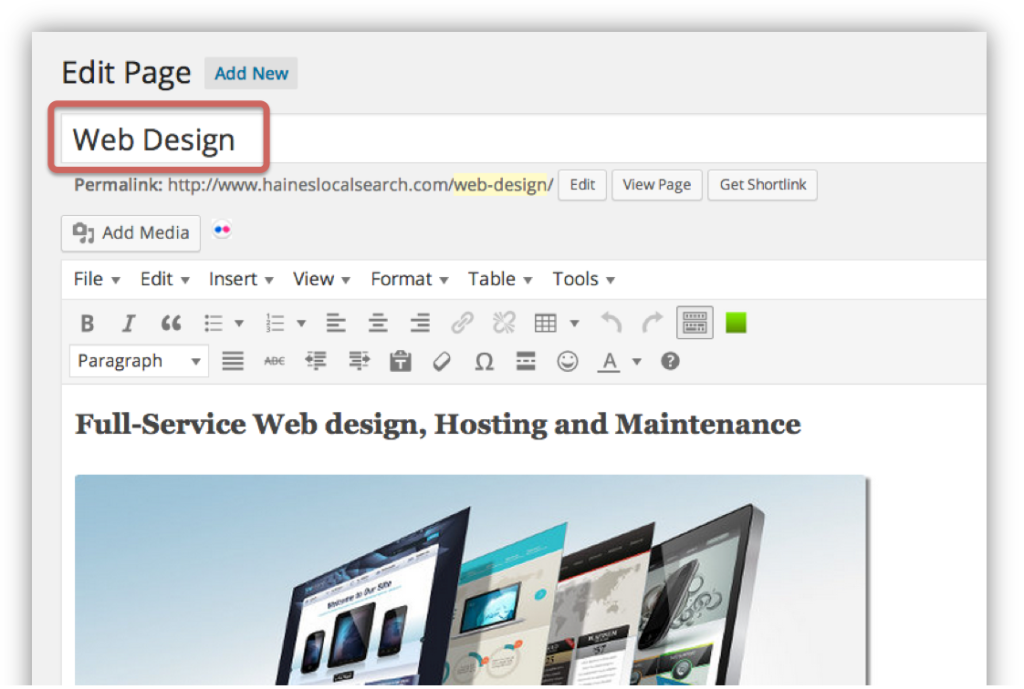In my companion article, The Non-Writer’s Guide to Writing for the Web, I gave you guidelines for creating effective website copy.
Humans aren’t the only audience you’re writing for. Search engines send out automated programs that crawl the web, searching for content to add to its database. What they find helps determine how well you rank in the search results.
There was a day when writing for the search engines meant sacrificing your readers on the altar of better search results. Sadly, many people still adhere to practices that are both unnecessary and detrimental.
That said, there are legitimate techniques that can improve your article or web page’s ranking.
We’re going to discuss familiar search engine optimization (SEO) concepts like titles, headings and descriptions. The only semi-technical term I’ll use is “keyword,” which are the words and phrases that best describe what your site is about.
Keyword Optimization
Keywords are simply words and phrases someone would use to search for you on Google.
For example, if your site is about dentistry, then your “keywords” might be words and phrase like:
- Dentist
- Dental
- Dentistry
- Dental office
- Teeth whitening
- Sedation dentistry
- Tooth whitening
- Cosmetic dentist
Keyword optimization is a fancy term for using those keywords as effectively as possible within your copy. There are no hard-and-fast rules for keyword use, but here are some general guidelines:
- Use your keywords or keyword phrases 2 or 3 times, at most, throughout your copy.
- Place keywords within first 50 words and in the concluding paragraph.
- If possible, don’t use the exact phrase each time; use synonyms and variations.
- If you’re a local business operating within a specific geographical area, then your location is also keyword.
Avoid Keyword Stuffing
Google offers a humorous example of keyword stuffing:
We sell custom cigar humidors. Our custom cigar humidors are handmade. If you’re thinking of buying a custom cigar humidor, please contact our custom cigar humidor specialists at custom.cigar.humidors@example.com.
Keyword stuffing is an attempt to manipulate a site’s ranking. Other examples are:
- Keywords in a list or group, or out of context, rather than natural prose.
- Blocks of text listing cities and states a web page is trying to rank for.
These techniques once worked. But over the years, search engines have become smarter. So the rule-of-thumb is the more human-friendly the content, the better the search engines tend to rank it.
Page (META) Keywords
Besides the page itself, there’s another place to add your keywords. These “META keywords” can only be seen in the behind-the-scenes HTML code of the page.
If you’re using WordPress, you’ll find a field to enter these in the Page/Post editor:

The location of this field will vary, depending on your theme and whether you’ve installed a plugin to handle titles, headings and descriptions. (More on this below.)
Here are some guidelines to follow:
- The keywords you add here should reflect actual keywords used on that page.
- Separate each keyword or keyword phrase by a comma, no spaces.
- Each page should have unique keywords.
Structuring Your Pages
Before we move on to titles, headings and descriptions, let’s talk about your site’s structure.
If your website were a book, then each web page is like a chapter, and the sections on the web page are like the individual pages in the chapter.
So best practices is to create a page for each product, service, or offering, and to use only the keywords that apply to that particular page. For example, our company website has separate pages for web design, search engine optimization, social media marketing, pay-per-click advertising, and so on.
Page Title
Your page title has a big impact on how well you rank in an online search, because it tells the search engines what the page is about. Therefore, each page should have a unique title that reflects the keywords used on that page.
From a human perspective, the title displays on the search results page:

You’ll notice my title gets cut off. That’s because I’ve made it too long. Unfortunately, Google uses pixels rather than character count to decide when to truncate a title.
There’s no magic number to prevent this, but limiting your title to 55 characters (including spaces) will keep it from happening 95 per cent of the time.
Since space is limited, avoid using stop words that carry no keyword value (such as: the, an, a, am, is, can, and, or, but, if, then, of, that, on, for, which).
Page Description
The description appears below the title on the search results page.

While this doesn’t affect your ranking, it tells potential human visitors what your site is about. A well-written description gives people a reason to click the link and visit your site.
Just like titles, Google limits the description by pixel width, so keep it at 150 characters or less (including spaces) to be safe.
Here are some additional guidelines:
- Include as many keywords as possible, so long as it reads naturally.
- The keywords you use should match the keywords used on that page.
- Give each page a unique description.
Adding the Description in WordPress
The WordPress Page/Post editor will have a field to enter the description. Just like the keyword field, the location will vary depending on your theme and whether you’ve installed a plugin to handle titles, headings and descriptions.

Page Heading
The heading is generally the first text you see on the page:

Just like titles, the heading tells search engines what the page is about and should be unique for every page. If you’re using WordPress, then what you enter here becomes the heading and the first half of your title:

The second half of your title is the name of your site — in my case it’s Haines Local Search. So this page’s title is Web Design | Haines Local Search.
Optimizing Your Images
In my companion article, I recommended setting editorial standards. That includes setting a standard image size for your pages and blog posts.
The size you choose will depend on your design. For our company website, 640 pixels wide is optimal.
Most stock images and digital photos are 3000 pixels or more. That means you need to resize your image in a photo editor like Photoshop or Gimp before uploading it. Otherwise, your page will load much slower.
Why should you care? Because in 2010, Google decided that website speed would have an impact on search ranking. Sites that load slowly will not rank well.
One more thing before uploading your image. Give it a descriptive file name, preferably one you want to rank for — it will help with your search engine rankings.
WordPress Plugins
If you’re using WordPress, there are plugins that give you more control over titles, headings and descriptions than WordPress does out-of-the-box. I recommend WordPress SEO by Yoast or All in One SEO Pack.
Another plugin to get is SEO Friendly Images. This optimizes your images by automatically adding an ‘ALT tag’ that matches your title. This is generally OK if your image is to just there to improve the look of the site. When an image is there for any other reasons you will want to write an ALT tag that is useful for visitors using a screen reader.
Sounds Great, but Why?
This may seem like a lot of work — and I wouldn’t argue that point. But what’s the use of creating a great article or web page if you do nothing to help it be found?
This is both the blessing and curse of self-publishing. The ability to create your own content is a wonderful thing. The time required to do it right, not so much.
 John Tabita
John TabitaFormer owner and partner of web firm Jenesis Technologies, John is currently Director of Digital Strategy at Haines Local Search, a company providing local search marketing solutions to SMBs, including print and Internet Yellow Pages, web design, and local SEO. When not working or spending time with his family, John offers great sales and marketing advice on his blog, Small Business Marketing Sucks. When not working or spending time with his family, John offers great sales and marketing advice on his blog, Small Business Marketing Sucks.


